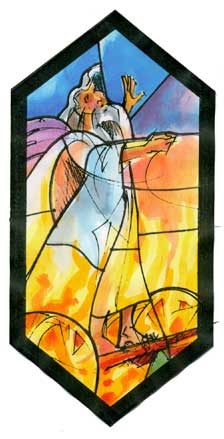|
|
|||

|
|||
Elijah
Window
 After the death of Solomon, Israel split into two separate kingdoms. David’s line continued to rule Judah in the South, while other dynasties ruled Israel in the North. The Mosaic Covenant was quickly forgotten, especially in Israel, where kings erected golden calves and altars to foreign gods, and where King Ahab (c. 870–850 B.C.) made Baalism Israel’s official religion, complete with temple prostitution and child sacrifice. Elijah was a prophet in Israel during the reign of Ahab. Through a number of miracles, he demonstrated Yahweh’s sovereignty to unbelieving Israel, the climax taking place on Mt. Carmel, in a showdown between Elijah and 450 prophets of Baal. The Baalites called on their god all day to consume their sacrifice with fire, to no avail. Then Elijah prepared his sacrifice, doused it with 12 jugs of water, and prayed. “Then the fire of the Lord fell,” consuming not only the sacrifice, but the wood, stones, dust, and water, as well. Yahweh was proclaimed to be God, but Baalism was not removed. Elijah’s dramatic career continued until shortly after Ahab’s death. But his story doesn’t end there. Rather, we are told that a chariot and horses of fire took Elijah to heaven in a whirlwind. After Elijah’s departure, both Israel and Judah continued their decline, until finally, in 722 B.C., Assyria destroyed Israel. Judah lasted another century before being exiled to Babylon (c. 587 B.C.). After about 50 years, some Jews were able to return to Judah, where they restored Jerusalem and renewed the Covenant; but they were not self-governing. The royal term “messiah” increasingly came to refer to a future king who would one day restore justice and peace. Because Elijah had been taken up, he became identified with the messenger who would prepare Israel for this coming Day of the Lord. In the New Testament, Elijah was seen in the person of John the Baptist, who prepared the way for Jesus, preaching repentance, proclaiming the kingdom of heaven, and introducing the One who not only would redeem Israel, but who would take away the sin of the entire world. The view of Elijah ascending in the chariot of fire brings our look at the Old Testament windows to a close. Yet, at the same time, it heralds what is to come, preparing us to see the Messiah, Jesus Christ.
Like Stars Appearing: The Story of the Stained Glass
Windows of St. George's Episcopal Church, Dayton, Ohio | |||
|
|||
